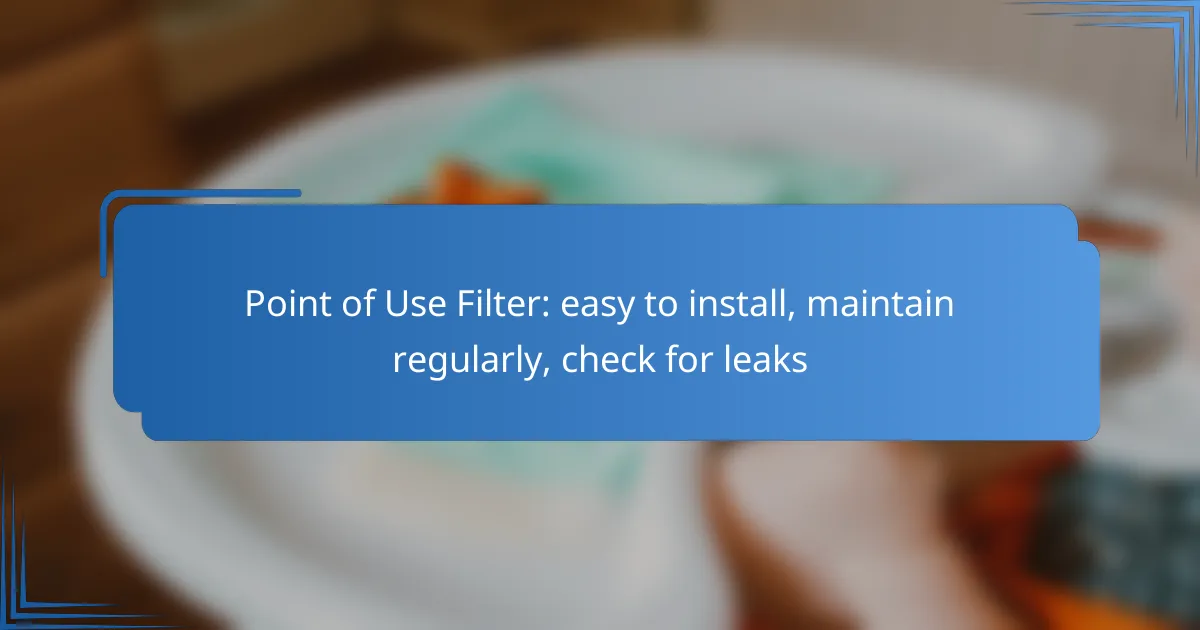Installing a point of use filter is a simple yet effective way to improve your water quality by connecting it directly to your faucet or under the sink. Regular maintenance, including cleaning and timely replacement of cartridges, is essential for optimal performance. Additionally, routine inspections for leaks can help ensure the longevity and reliability of your filter system.

How to install a point of use filter?
Installing a point of use filter is a straightforward process that can enhance your water quality significantly. It typically involves connecting the filter directly to your faucet or under the sink, ensuring clean water is readily available.
Step-by-step installation guide
Begin by turning off the water supply to your faucet. Next, remove the existing faucet aerator or connector, and attach the filter according to the manufacturer’s instructions. Ensure all connections are tight to prevent leaks.
After securing the filter, turn the water supply back on and check for any leaks. If everything is secure, run the water for a few minutes to flush the system before use.
Tools required for installation
The installation of a point of use filter typically requires a few basic tools. You will need an adjustable wrench, a screwdriver, and possibly a pair of pliers. Having a towel handy can help manage any spills during the process.
For some filters, additional components like Teflon tape may be necessary to ensure a watertight seal at the connections.
Common installation mistakes
One common mistake is failing to turn off the water supply before starting the installation, which can lead to messy leaks. Another frequent error is not tightening connections adequately, resulting in water leaks after installation.
Additionally, overlooking the manufacturer’s instructions can lead to improper installation, affecting the filter’s performance. Always double-check that all parts are compatible and securely attached before finishing the installation process.

What maintenance is required for point of use filters?
Point of use filters require regular maintenance to ensure optimal performance and water quality. This includes a consistent cleaning schedule, timely replacement of filter cartridges, and vigilance for any signs indicating maintenance needs.
Regular cleaning schedule
Establishing a regular cleaning schedule is crucial for maintaining point of use filters. Typically, cleaning should occur every month or two, depending on usage and water quality. Use a mild detergent and warm water to clean the exterior and any removable parts.
Additionally, check the manufacturer’s instructions for specific cleaning recommendations, as some filters may have unique requirements. Keeping the filter clean helps prevent buildup that can affect water flow and quality.
Replacement filter frequency
Replacement frequency for filters varies based on the type of filter and water usage. Generally, point of use filters should have their cartridges replaced every 6 to 12 months. High usage or poor water quality may necessitate more frequent changes.
Always refer to the manufacturer’s guidelines for the specific filter model to determine the ideal replacement schedule. Keeping track of replacement dates can help ensure consistent water quality and filter efficiency.
Signs of maintenance needs
Be alert for signs that indicate your point of use filter requires maintenance. Common indicators include a noticeable decrease in water flow, unusual tastes or odors in the water, or visible sediment in the filter. These symptoms suggest that the filter may be clogged or the cartridge needs replacing.
Regularly inspect the filter for leaks or damage as well. If you notice any leaks, address them immediately to prevent water waste and potential damage to your plumbing system.

How to check for leaks in point of use filters?
To check for leaks in point of use filters, regularly inspect the connections and the filter unit itself for any signs of water accumulation or moisture. Quick visual checks and simple tests can help identify potential leaks before they become significant issues.
Leak detection methods
Common leak detection methods include visual inspections and pressure tests. During a visual inspection, look for water stains, dampness, or pooling around the filter and its connections. Pressure tests can help determine if there is a drop in water pressure, indicating a possible leak.
Another effective method is to use a moisture meter, which can detect hidden leaks by measuring the moisture level in surrounding materials. This tool is particularly useful in areas where leaks might not be immediately visible.
Common leak sources
Leaks in point of use filters often originate from loose connections, damaged hoses, or worn-out seals. Regularly check the fittings and tighten any loose connections to prevent leaks from occurring.
Additionally, inspect the filter cartridge for any cracks or signs of wear. Over time, these components can degrade, leading to leaks that may require replacement to maintain proper function.
What to do if a leak is found
If a leak is detected, first turn off the water supply to the filter to prevent further water damage. Next, identify the source of the leak by checking all connections and components.
Once the source is located, you may need to replace damaged parts or tighten loose connections. If the issue persists, consider consulting a professional plumber to ensure the filter is properly repaired and functioning effectively.

What are the benefits of point of use filters?
Point of use filters provide immediate access to cleaner water directly at the tap, enhancing water quality and convenience. They are easy to install and maintain, making them a practical choice for households looking to improve their drinking water without significant investment.
Improved water quality
Point of use filters significantly enhance water quality by removing contaminants such as chlorine, lead, and sediment. These filters often meet or exceed standards set by health organizations, ensuring that the water you consume is safer and tastes better.
Regular maintenance, including timely replacement of filter cartridges, is essential to maintain optimal performance. Users should check the manufacturer’s guidelines for replacement intervals, which typically range from every few months to a year, depending on usage and filter type.
Cost-effectiveness
Investing in point of use filters can lead to substantial savings compared to purchasing bottled water. The cost of filtered water is generally much lower, often just a few cents per gallon, compared to the price of bottled alternatives.
Additionally, these filters can reduce the need for costly plumbing repairs by preventing sediment buildup in pipes and appliances. Over time, the savings on both water purchases and maintenance can outweigh the initial installation costs.
Convenience of use
Point of use filters are designed for easy installation, often requiring no professional help. Many models can be attached directly to existing faucets or installed under sinks with minimal tools.
Maintenance is straightforward, typically involving simple tasks like replacing filter cartridges. Regular checks for leaks should be part of the maintenance routine to ensure the system remains effective and to prevent water damage.

What are the best point of use filters available?
The best point of use filters are those that effectively remove contaminants from water at the tap level, providing clean drinking water directly from your faucet. Popular options include reverse osmosis systems, activated carbon filters, and UV purifiers, each catering to different water quality needs and installation preferences.
Top-rated models for home use
Some of the top-rated point of use filters for home use include the APEC ROES-50, which is a reverse osmosis system known for its high filtration efficiency and long-lasting filters. Another popular choice is the Brita Tap Water Filter, which offers easy installation and a compact design suitable for most kitchen faucets.
For those seeking a UV purification option, the Home Master HydroPerfection is highly regarded for its ability to eliminate bacteria and viruses while maintaining essential minerals in the water. Each model varies in price, typically ranging from around $30 to several hundred dollars, depending on the technology and features.
Comparative features of popular brands
When comparing popular brands, consider factors such as filtration method, capacity, maintenance requirements, and installation ease. Reverse osmosis systems generally provide the highest level of purification but may require more frequent filter changes and a dedicated space under the sink.
Activated carbon filters, like those from PUR and Brita, are easier to install and maintain, often needing only a cartridge replacement every few months. UV filters, while effective against microorganisms, may require additional pre-filtration to remove larger particles, which can affect their efficiency.
Customer reviews and ratings
Customer reviews often highlight the effectiveness and convenience of point of use filters. Many users appreciate the taste improvement in their water and the peace of mind that comes with knowing contaminants are being removed. Ratings for these products typically range from 4 to 5 stars on popular retail platforms.
Common feedback includes the ease of installation for models like the Brita filter, while some users of reverse osmosis systems mention the need for periodic maintenance as a drawback. Overall, customer satisfaction tends to be high, especially when the filters meet specific water quality needs.

What factors to consider when choosing a point of use filter?
When selecting a point of use filter, consider factors such as filter type, installation ease, maintenance requirements, and potential for leaks. These aspects will help ensure you choose a filter that meets your needs effectively and efficiently.
Filter type and technology
Point of use filters come in various types, including activated carbon, reverse osmosis, and UV filters. Activated carbon filters are effective for removing chlorine and improving taste, while reverse osmosis systems can eliminate a broader range of contaminants, including heavy metals and bacteria.
When choosing a filter type, consider the specific contaminants present in your water supply. For instance, if your water has high levels of lead, a reverse osmosis system may be the best choice. Additionally, think about the flow rate and capacity of the filter to ensure it meets your household’s daily water needs.
